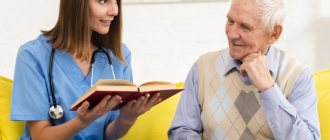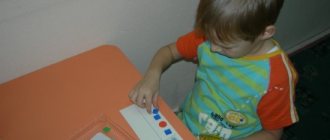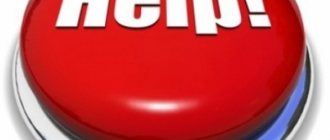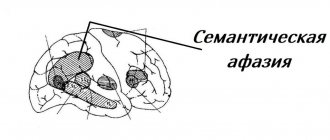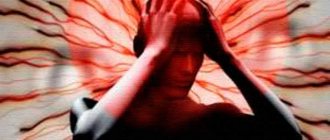Problems with using or understanding language (aphasia) appear, according to statistics from studies conducted by NABI (National Stroke Association), in 25 patients out of 100. Every fourth patient experiences difficulties associated with verbal communication - the ability to speak, write or understand spoken language. and written language. This indicates that acute cerebrovascular accident affected one or more language control centers.
Aphasia is a symptom of brain damage, not a disease. As individual as the picture of damage is, the manifestation of aphasia in each patient is as individual. This condition determines the individual nature of the selection of speech restoration techniques after a stroke for each patient.
How to restore the ability to speak in an adult after losing it?
How long it takes for speech function to recover depends on how severely the brain was damaged.
Therefore, in some patients, the ability to speak is restored quite quickly (within a few weeks or months), while in others it takes years, and it is difficult to predict how long it will take. To restore patients who have suffered a stroke, the following types of rehabilitation are used:
- Drug therapy.
- Classes with a speech therapist.
- Physiotherapy.
- Massage.
- Surgical intervention.
Medicines
During rehabilitation after a stroke, the doctor prescribes several groups of drugs to the patient that help reduce side effects, improve the condition and help the patient quickly return to their normal lifestyle:
- Muscle relaxants.
- Antidepressants.
- Anticonvulsants.
- Antiplatelet agents.
Muscle relaxants
On a note. In the third month after a stroke, the patient may develop muscle hypertonicity, which greatly slows down the rehabilitation process.
Then muscle relaxants are prescribed that can reduce excessive muscle tone. The best muscle relaxants for stroke:
- Sirdalud (cost in Moscow from 227, in St. Petersburg from 176).
- Tizalud (cost in Moscow from 160, in St. Petersburg from 125 rubles).
Antidepressant series drugs
Almost 80% of patients suffer from depression after a stroke, which slows down the recovery process. In this case, antidepressants are prescribed. The best antidepressants for stroke:
- Nortriptyline (cost in Moscow from 990, in St. Petersburg from 1,000 rubles).
- Paxil (cost in Moscow from 650, in St. Petersburg from 660 rubles).
Anticonvulsants
When seizures occur, anticonvulsants are prescribed, but they should be taken with caution, as this group of drugs can cause side effects. The best anticonvulsants for stroke:
- Finlepsin (cost in Moscow from 215, in St. Petersburg from 193 rubles).
- Convulex (cost in Moscow from 116, in St. Petersburg from 135 rubles).
Antiplatelet agents
If after a stroke the patient’s blood becomes more viscous, this slows down the recovery of brain tissue. In this case, the help of antiplatelet agents is required to prevent the formation of blood clots. The best antiplatelet drugs for stroke:
- Reopoliglyukin (cost in Moscow from 102, in St. Petersburg from 110 rubles).
- Clopidogrel (cost in Moscow from 226, in St. Petersburg from 205 rubles).
Important! Any medications should be prescribed only by the attending physician. Do not self-prescribe medications, otherwise this can only worsen the patient’s condition.
Medication alone does not provide much benefit, but it does help progress recovery when used with other types of therapy, such as speech therapy and physical therapy.
- How exactly does speech restoration proceed after a stroke?
Classes with a speech therapist
At the first lesson, the speech therapist draws up a plan for each patient individually. The following exercises are required:
- Reading tongue twisters.
- Drawing.
- Mimic and speech therapy massage.
If all the specialist’s recommendations are carefully followed, about 20-30% of patients with moderate and severe speech disorders begin to speak normally by the time they are discharged from the hospital. Classes can also be held at home. The exercise program must be combined with medications, physical therapy and other types of rehabilitation.
Physiotherapy
This type of rehabilitation stimulates muscle recovery and helps to achieve better results from classes with a speech therapist and from taking medications.
- Magnetotherapy. This procedure stimulates all processes in the brain, and also improves the functioning of the endocrine and nervous systems. A rather painful method, but it is considered one of the most effective. The patient's condition improves after 2-3 weeks.
- Dorsanval. Prescribed for poor blood supply to the brain and limbs. After a whole course of procedures, which is at least 5-7 sessions that take place over 2-3 weeks, the patient’s condition improves significantly.
Massage
Therapeutic massage for stroke significantly improves blood supply to the affected tissues, which increases the flow of oxygen and other nutrients to them. In addition, massage helps relieve muscle and psychological tension. A therapeutic massage course usually consists of 10 sessions , but can be adjusted individually for each patient.
Note! A massage course can only be conducted by a qualified specialist with a medical education.
Surgery
A method such as surgery is resorted to in extreme cases, when other methods do not improve the patient’s condition and cannot restore lost speech. To restore speech, a neurosurgical operation is performed, which creates additional connections between healthy tissues and vessels in the speech area of the brain, without affecting the damaged areas.
Speech impairment due to stroke
Stroke can be hemorrhagic or ischemic. With a hemorrhagic stroke, too much blood flows to the brain, and arteries may rupture, but with an ischemic stroke, on the contrary, not enough blood flows to the brain.
Hemorrhagic stroke is less common, but causes more serious consequences for the patient. But in both cases, the areas of the brain responsible for speech may be damaged in a person.
- Exercises after a stroke at home for recovery
If speech fails, then the disturbances occurred in the left hemisphere of the brain. With such a stroke, the right side is paralyzed and there is no speech.
Strokes with paralysis on the right side occur more often than on the left. And this is better for the patient, since in this case it is easier to make a diagnosis, since speech disorders are always manifested.
Such disorders are called aphasia. In this case, disturbances can occur in different parts of the brain. Depending on this, the consequences may be different. How to restore speech after an ischemic or hemorrhagic stroke?
Let's look at the types of aphasia and their consequences:
- Amnestic . A person can communicate, but periodically forgets the names of the objects he is talking about.
- Semantic . In this case, you need to talk to the patient exclusively in simple sentences; he simply will not understand complex ones.
- Sensory . A complex type of aphasia in which the patient does not understand speech at all. For him it comes down to a set of sounds. At the same time, he practically cannot understand the meaning of what was said.
- Motor . A person understands everything, but cannot say anything coherently, confuses sounds and words, or gets stuck on one sound combination.
- Total . The patient does not understand anything, does not recognize anyone, cannot say anything. Most often, this phase occurs immediately after a stroke. After some time, it can turn into motor.
No one can give a 100% guarantee that the patient will be able to speak at all. But if you act quickly, correctly, follow all the recommendations of specialists, create an atmosphere of patience, love and care around a sick relative, support him as much as possible in his desire to recover, then he has a much better chance of quickly recovering his speech loss.
Simple speech problems can be solved in 2–6 months with special regular training and exercises. If the degree of violation is greater, then more time will be required.
Sometimes this can last up to several years. A forecast of 5-10 years is considered a period after which changes for the better are hardly possible. However, miracles of recovery happen, but they most often lie in the realm of intangible reality.
People say, “Houses and family walls heal.” This relates to the question of how relatives of a stroke patient should behave. The first questions they ask the doctor are: “Is speech restored after a stroke? Is it even possible to restore speech after a stroke? How long does it take for speech to be restored after a stroke? Relatives can be understood. But a lot depends on their behavior, on their actions.
Here are the usual recommendations from doctors to the patient’s relatives:
- The patient must feel that his family needs him, that he is valuable to her, that his relatives believe in him, love him, sincerely wish for his recovery and do not doubt it at all. In this case, he will have additional motivation to get back on his feet as quickly as possible. This means there will be energy for this.
- You need to constantly talk with the patient and in his presence. Then he will feel involved in the family. But the most important thing: if the topic is important to him, he will try to talk.
- It’s good if his favorite music, the songs he used to sing, are played in the house. The inner desire to sing along can well stimulate the awakening of his speech impulses.
- But it is better to remove excess noise, variety and volume of sounds so as not to overload the patient. You need to talk to him quietly, calmly, without explosive emotions. Surround him with your kindness. At the same time, there is no need to emphasize every time that he is terminally ill.
- Relatives need to have maximum patience, since they are the ones who must become constant assistants for the patient when performing the exercises that the speech therapist will show. And under no circumstances should you react with irritation if you can’t do the exercise.
Work of the patient’s relatives with a speech therapist-aphasiologist
The importance of cooperation between family members and the speech therapist working with the patient cannot be ignored. Often the speech therapist invites relatives to attend some classes so that they can understand the methodology and technique of performing the exercises. After all, the key to results is regular and thorough work.
It is important that relatives maintain a positive attitude in the patient and provide him with psychological support. However, in no case should you overload the patient in an effort to achieve results as quickly as possible.
Here, relatives will also be helped by communication with a speech therapist, who will be able to explain the essence of the processes taking place and tell them how to do homework to correct speech disorders.
Advice from a speech therapist to family members of a stroke patient:
- Do not limit communication with a relative, even in case of significant speech impairment. Calm, positive conversations on topics that interest him stimulate him to engage in dialogue and do not allow him to feel alienated from society.
- Try not to express dissatisfaction with the slow results of speech restoration or incorrectly performed exercises. The speech therapist always tries to develop a sense of success in the patient; a positive attitude gives strength and desire to work further.
- Carefully follow your speech therapist's instructions for doing your homework . Remember that only a specialist knows how to help your relative.
- Do not overload the patient; excessive loads, even with good aspirations, can lead to the opposite result.
- Limit your TV viewing as it can also contribute to overload.
Support your relative in his activities, emphasize even minor achievements and do not abandon corrective efforts. In cooperation with a specialist, you can completely restore your speech!
A set of activities after the crisis
Despite the fact that each type of aphasia has its own exercises for restoring normal speech after a stroke, it should be remembered that all disorders are mixed in nature and require a systematic, special approach.
A set of special classes will help not only regain lost skills, but also improve a healthy person’s oratory abilities and diction.
- How to avoid stroke in women: prevention with drugs and folk remedies
During training, it is recommended to adhere to the recommendations of the speech therapist, which include:
- Pull the lip folds into a tube, hold for 3-5 seconds, then repeat (up to 10 approaches).
- Use the lower part of your jaw to grab the top of your lip, hold for 2-3 seconds, release (5-10 times).
- Similar to the previous exercise, only in reverse - pinch the lower part with your upper lip.
- Open your mouth slightly, stretch your neck forward, stick out your tongue (as far as possible), hold for a few seconds (5-10 repetitions).
- We take turns licking the upper and lower lip folds, from left to right, then vice versa (up to 10 approaches).
- Draw a tube with your tongue.
- Lick the lip folds in a circle.
- Close your mouth and reach your lower palate with your tongue.
- Clicking your tongue like a horse while running.
- Close your mouth, open your teeth, move your tongue in a circular motion between the labial folds and teeth.
- Try to smile, showing all your teeth, then repeat the movement with your jaw closed.
- Hiss like a snake, moving your tongue out of your mouth.
- Send a kiss while smacking your lips loudly.
- Use your tongue to reach your chin, after the tip of your nose.
Speech therapy exercises after stroke
Exercises for aphasia can be performed in different sequences 2-3 times a day, combining them with other activities to restore speech functions. Logically complete phrases with an assistant, learn tongue twisters, poems, counting rhymes, songs, listen to your favorite pieces of music.
In order for speech to be restored completely (as far as possible), it is necessary to approach the implementation of the recommendations of the speech therapist or the attending physician with all responsibility. There should be complete silence in the room during classes.
Advantages of visiting the Yusupov Hospital
The main advantages include: our own staff of caregivers, the opportunity to stay with relatives, varied meals, round-the-clock supervision, classes for 5-6 hours a day.
Experienced specialists at the Yusupov Hospital practice treatment of speech loss due to stroke. A full diagnostic is preliminarily provided to identify the severity of disorders and assess the general state of health. For this purpose, modern equipment is often used (computed (CT) and magnetic resonance imaging (MRI) are prescribed).
According to the severity of the clinical case, doctors develop a suitable recovery method. Examinations are necessary both before starting treatment and for subsequent observation and monitoring of dynamics. The Yusupov Hospital staff includes experienced neurologists, speech therapists, massage therapists and exercise therapy instructors. Thanks to the highly qualified specialists and individual approach, it is possible to significantly reduce the length of stay in the inpatient department. To make an appointment, you can call the numbers listed on the website or leave a request online.
Other methods of treatment and prophylaxis
Complex speech impairment after a stroke can be eliminated using other methods of therapy, which only a qualified neurologist can recommend. For these purposes, he will conduct a comprehensive diagnosis, based on the results of which he will prescribe appropriate treatment, including:
- Physiotherapy – electrical stimulation of speech muscle tissue. It is most often used for the motor type of aphasia. But modern doctors resort to it in rare cases.
- Acupuncture - used to restore articulation and speech function. Prescribed for motor type of pathology.
- Functional biofeedback. This technique is based on visual influence on the speech muscles. It is not recommended for use in patients with perception disorders.
Complex therapy, including these methods of influence, helps improve speech functions. The complexity of the rehabilitation period and how long it will take to treat the consequences of a hemorrhagic or ischemic stroke depend on the location of the hemorrhage and its extent. In some cases, recovery takes only a month, in others up to 2 years.
Problems with speech after a cerebral hemorrhage can consist not only of direct damage to the centers, but also of paralysis of facial muscle tissue. As a result, the articulatory muscles stop doing their job, and therapy and rehabilitation are carried out as for coordination disorders.
Acupuncture – used to restore speech function
What is aphasia and what are its main forms?
In order to understand exactly how to restore speech in a victim after a stroke, it is advisable to understand the mechanism of development of aphasia. So, as you probably understand, in the medical community, certain speech disorders associated (or not associated) with a stroke are called aphasia. In other words, aphasia in one form or another is always a systemic lesion of speech activity, as a result of a certain damage to the cerebral cortex.
Doctors themselves distinguish several main types of aphasia that occurs after a brain stroke, which we present in the form of a table:
Speech therapy exercises to restore speech after a stroke at home
Let us now consider what methods a specialist can offer to restore a patient’s speech, and how they should be applied.
Articulation and breathing exercises
First, the person is asked to simply breathe, then, as he exhales, pronounce certain consonant sounds, one sound per exhalation. After this, while exhaling, all these sounds are pronounced in a row. There are no more than four of them. Sounds can be pronounced while exhaling, also with the chin raised.
Articulation gymnastics after a stroke
It includes exercises for the tongue, lips, voice, and facial muscles.
Exercises for the tongue and soft palate
- Stick your tongue out of your mouth and hold it there for a few seconds.
- Pull it down again and bend it up, hold it for a while.
- Pull it down and direct it first to the right corner of the mouth, then to the left.
- Move the tip of your tongue back and forth across the roof of your mouth.
- Direct your tongue to the right and left cheek.
- Click your tongue, first once, then twice, then three.
- Relax your tongue and, moving it back and forth, lightly bite with your teeth.
- Lick your lips first in one direction, then in the other.
Lip exercises
- Move your lips forward.
- Make a smile with your mouth closed.
- Bare your teeth and raise your upper lip, hold this for a couple of seconds.
- Puff out your cheeks and pump the air from side to side, rolling the air around your mouth.
- Relax your lips and blow through the gap in them.
Voice exercises
Speech gymnastics is performed for ischemic or hemorrhagic stroke.
- We pronounce all the vowel sounds separately, first long, then short, while exhaling. After this, as you exhale, we pronounce all the sounds in a row.
- We say the sound Y only articulatory, without sound, and feel the tension under the chin.
- We pronounce all the vowel sounds in a row, flowing into one another, alternately emphasizing different sounds.
- We pronounce consonant sounds, first unvoiced, separately, then one after another on one exhalation. After this, we pronounce voiced sounds in the same way. We add consonant sounds with vowels into certain syllables, while alternating paired unvoiced and voiced consonants.
All combinations of sounds, their permutations and combinations are determined by the speech therapist.
Tongue twister exercises after a stroke
First, we ask the patient to finish the tongue twister he knows, gradually increasing the number of words he says. If possible, we bring the exercise to perfection.
Exercises for facial muscles
- Raise your eyebrows, lower them, frown, relax.
- Open your mouth wide, try to stretch it, then relax it.
- Smile without opening your mouth.
- Inflate and deflate your cheeks.
- Pull your lips out as if for a kiss.
- Extend your tongue as far as possible in different directions from your mouth.
- Move your lower jaw carefully, first to the left, then to the right, then in a circle.
Speech therapy massage after stroke
After completing a set of exercises, it is necessary to apply a facial massage to each area of the face.
It is important that massage movements are selected only by a specialist. Some areas of the face will need to be relaxed, while others will need to be toned. If you approach this on your own, you can cause irreparable harm.
In addition to massaging the facial muscles directly, they massage the tongue, lips, inner surface of the cheeks, ears, scalp, and hands. All this relieves muscle stiffness and thus liberates speech.
